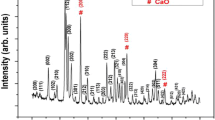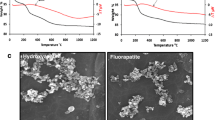Abstract
Glass ionomer cements (GICs) are clinically appealing dental materials with unique characteristics that make them suitable as restorative and luting materials. However, the application of GIC under mechanical loading has been limited by its poor mechanical performance. The aim of this study was to investigate the effect of date seed (DS) microparticles as a reinforcement material for conventional glass ionomer cement. Date seed powder was incorporated into the powder component of GIC at 1, 3, and 5 wt%. Glass powder without date seed powder was used as a control sample. Glass ionomer cement reinforced with DS was analyzed using various mechanical properties such as compressive strength (CS), Vickers microhardness (VH), and impact strength (IS). The surface inspection was investigated using a scanning electron microscope (SEM). The nature of DS and GIC-DS powder was determined using Fourier transform infrared (FTIR). The results showed that the incorporation of 5 wt% of DS reinforcement into GIC significantly improved the microhardness, impact strength, and compressive strength compared to the control sample of GIC. On the other hand, the results revealed that the weight percentage of DS plays a noteworthy role in deciding the properties of glass ionomer cement. The FTIR results revealed that a physiochemical interaction occurred between the GIC and the DS. The results indicated that the use of date seed powder as reinforcement can enhance the mechanical properties of glass ionomer cement in artificial saliva.






Similar content being viewed by others
References
M. Waters, Introduction to dental materials. Br. Dent. J. 192(7), (2002)
D.C. Smith, Polyacrylic acid-based cements: adhesion to enamel and dentin. Oper Dent 5, 177–183 (1992)
A.D. Wilson, Acid-base cements, their biomedical and industrial applications (The Press Syndicate of the University of Cambridge, 1993), pp. 116–175
S. Singh, Advances in glass ionomer cement: a review. Indian J. Contemp. Dent. 7(2), 32 (2019)
N.-S. Kampanas, M. Antoniadou, Glass ionomer cements for the restoration of non-carious cervical lesions in the geriatric patient. J Funct Biomater 9(3), 42 (2018)
B. Culbertson, New polymeric materials for use in glass-ionomer cements. J. Dent. 34(8), 556–565 (2006)
J.W. Mclean, Proposed nomenclature for glass-ionomer dental cements and related materials. Quintessence Int 25, 587–589 (1994)
U. Lohbauer, Dental glass ionomer cements as permanent filling materials?—properties, limitations future trends. Materials 3(1), 76–96 (2009)
A. Moshaverinia et al., A review of powder modifications in conventional glass-ionomer dental cements. J. Mater. Chem. 21(5), 1319–1328 (2011)
M. Nuri Sari et al., Effect of nano-hydroxyapatite incorporation into resin modified glass ionomer cement on ceramic bracket debonding. J. Iranian Dent. Assoc. 26(3), 208–213 (2014)
I.A. Rahman et al., One-pot synthesis of hydroxyapatite–silica nanopowder composite for hardness enhancement of glass ionomer cement (GIC). Bull. Mater. Sci 37(2), 213–219 (2014)
N.S. Rejinold, G. Choi, J.-H. Choy, Chitosan hybrids for cosmeceutical applications in skin, hair and dental care: an update. Emergent Mater. 4(5), 1125–1142 (2021)
E. Hatunoğlu et al., Antibacterial and mechanical properties of propolis added to glass ionomer cement. Angle Orthod 84(2), 368–373 (2014)
R.M. Abdallah, A.M. Abdelghany, N.S. Aref, Myrrh addition to a conventional glass-ionomer cement: influence on physical and antibacterial properties. Egypt. Dent. J. 62(2-April (Part 1)), 1483–1491 (2016)
X. Bao et al., Enhancing mechanical properties of glass ionomer cements with basalt fibers. Silicon 12(8), 1975–1983 (2020)
H.I. Elkhouly, Comparison of the effects of nano date seed as reinforcement material for medium-density polyethylene (MDPE) and polyethylene terephthalate (PET) using multilevel factorial design. Polym. Polym. Compos. 29(9), 1462–1471 (2021)
H.I. Elkhouly, M.A. Rushdi, R.K. Abdel-Magied, Eco-friendly date-seed nanofillers for polyethylene terephthalate composite reinforcement. Mater. Res. Express 7(2), 025101 (2020)
J. Klimek, E. Hellwig, G. Ahrens, Fluoride taken up by plaque, by the underlying enamel and by clean enamel from three fluoride compounds in vitro. Caries Res. 16(2), 156–161 (1982)
I. ISO, 9917-1: dentistry-water-based cements—part 1: powder/liquid acid–base cements (International Organization for Standardization, Geneva, Switzerland, 2007)
R. Petersen, Discontinuous fiber-reinforced composites above critical length. J. Dent. Res. 84(4), 365–370 (2005)
V. Mittal, A. Chaudhry, N.B. Matsko, “True” biocomposites with biopolyesters and date seed powder: mechanical, thermal, and degradation properties. J. Appl. Polym. Sci. 131(19), (2014)
X. Xu, J.O. Burgess, Compressive strength, fluoride release and recharge of fluoride-releasing materials. Biomaterials 24(14), 2451 (2003)
M.A.B. Paschoal et al., Fluoride release profile of a nanofilled resin-modified glass ionomer cement. Braz. Dent. J. 22, 275 (2011)
M. Gandolfi et al., Fluoride release and absorption at different pH from glass-ionomer cements. Dent. Mater. 22(5), 441 (2006)
A. Wiegand, W. Buchalla, T. Attin, Review on fluoride-releasing restorative materials—fluoride release and uptake characteristics, antibacterial activity and influence on caries formation. Dent. Mater. 23(3), 343 (2007)
A. Zandi Karimi, Development of glass ionomer cements with improved mechanical and remineralizing properties by incorporation of 45S5 Bioglass®-ceramic (Concordia University, 2019)
F. Sayyedan et al., Effect of forsterite nanoparticles on mechanical properties of glass ionomer cements. Ceram Int 40(7), 10743 (2014)
G. Zappini, A. Kammann, W. Wachter, Comparison of fracture tests of denture base materials. J Prosthet Dent 90(6), 578–585 (2003)
S. Thomaidis et al., Mechanical properties of contemporary composite resins and their interrelations. Dent. Mater. 29(8), e132–e141 (2013)
A. Moshaverinia et al., Effects of incorporation of hydroxyapatite and fluoroapatite nanobioceramics into conventional glass ionomer cements (GIC). Acta Biomater. 4(2), 432–440 (2008)
A. Yap et al., Experimental studies on a new bioactive material: haionomer cements. Biomaterials 23(3), 955–962 (2002)
Acknowledgements
The authors would like to thank the Department of Materials Engineering, College of Engineering, Mustansiryiah University for supporting this work.
Author information
Authors and Affiliations
Contributions
The manuscript was written through the contributions of Fryal Adel and Lubna Ghalib. Fryal Adel and Lubna Ghalib have given to the final version of the manuscript.
Corresponding author
Ethics declarations
Conflict of interest
The authors declare no competing interests.
Rights and permissions
Springer Nature or its licensor (e.g. a society or other partner) holds exclusive rights to this article under a publishing agreement with the author(s) or other rightsholder(s); author self-archiving of the accepted manuscript version of this article is solely governed by the terms of such publishing agreement and applicable law.
About this article
Cite this article
Adel, F., Ghalib, L. Improving the mechanical properties of glass ionomer cements by incorporation of date seed microparticles. emergent mater. 6, 1081–1088 (2023). https://doi.org/10.1007/s42247-023-00511-1
Received:
Accepted:
Published:
Issue Date:
DOI: https://doi.org/10.1007/s42247-023-00511-1




